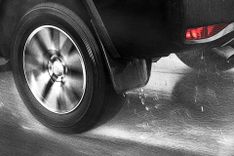Harvesting wasted energy from your car?


As the human industrial enterprise continues to grow, it is imperative that we find alternative means to fuel our economic expansion. The rate at which energy consumption is growing is not nearly going to be matched by the growth in supply, at least as far as traditional sources of energy are concerned.
It is in this context that renewable energy sources have assumed great importance in the last few years. Technologies like energy harvesting have attracted enormous investment and interest in recent times. There has been a spate of novel energy harvesting modalities that have been made public by several leading researchers around the world.
This is not a fad by any means - the reason behind this trend is quite intuitive actually - The core concept on which energy harvesting is based is that enormous quantities of energy go to waste around us nearly all the time; What if we could find a way to harvest some of this energy and convert it into usable electricity? It wasn’t long ago that this idea sounded a tad too ambitious and far fetched for any serious bets to be placed on it. Now, however, this very simple idea has spawned quite a few technologies, which are all finding real-world application to some extent.
Harnessing wasted energy
In effect, only about 15% of the gas that your car consumes actually gets through to your drivetrain as usable power - the power that propels your car against the resistance of tarmac through air - the rest of it is lost as heat, sound, and other energy inefficiencies.
The sheer magnitude of these energy losses can be minimised with top drawer engineering expertise, but it can’t entirely be helped. There is always going to be some loss of power. But here’s the best part - while we can’t always help the fact that there will be energy losses in any system, what if we harvested this energy that is essentially going to waste and convert it into electricity that can be used to power low-power IoT devices.
That’s essentially the thought that led Lei Zuo, an associate professor of mechanical engineering in Virginia Tech’s College of Engineering, to come up with a rather nutty sounding idea - what if we harvested energy from the suspension system of a moving motor vehicle?
More specifically, he wondered if he could harvest energy from the vibrational energy that goes through the suspension system when on road. He estimated that a car’s shocks would be able to account for anywhere between 100 and 400 watts of energy on well-maintained tarmac and even more on bad roads. All things considered, those kinds of numbers would indicate a 5% increase in the overall energy efficiency of the machine. If extrapolated onto a larger scale, this would correspond to net savings of $13 to $18 billion.
How does the harvester work?
Zuo’s shock absorber works by relaying the vibrational energy from the car’s suspension going over bumps and rough roads, into rotational force that is then used to run a generator, converting the energy into electricity that can be stored. This energy is then directed into the vehicle’s battery, where it is used to ease the load on the main alternator.
Sounds simple enough right? What’s the big deal then?
Well, the big deal is that to create this energy harvesting device, the team had to find a solution to one of the central challenges of harvesting vibrations - finding a way to convert the up-down motion into a single-pointed motion that can be used to run a generator.
Professor Zuo’s system uses an intricate system of gears, which allow for forces in both directions to be converted into power. Professor Zuo goes on to explain that this setup also contributes towards the device working at a steady pace, which serves to reduce the load on the components, which makes the device more robust and reliable over a long period of time.
The generator in the device is built to make the most of every bit of energy it receives. When the group tested their device on college campuses, they estimate that they are able to harvest about 60% of the total energy available - which would place their device in a league of its own amongst its competitors. Professor Zuo is certain that these numbers can be pushed up significantly if precision manufacturing is employed in the making of the components. He also claims that the best part about the energy harvester is that it can be retrofitted onto any existing model, without requiring any special mods. This energy harvester is only one of several models that Professor Zuo and his team of students have engineered in recent years - Among others, they have also designed linear-electromagnetic and hydroelectric shock absorbers.
Real-world savings
Energy harvesting, so far, has been seen as a very promising but not yet scalable power source. As of today, energy harvesting technologies are predominantly directed towards IoT devices, which don’t require a lot of power in order to function.
A number of promising technologies are emerging which are vying to be at the cutting edge of energy harvesting technologies - Professor Zuo’s device, for instance, boasts of an incredibly high efficiency, which makes it particularly nifty, if it can be made commercially viable and brought to market.
“When we present this technology to drivers, they ask about fuel efficiency and how much money this will save them. When we present it to car manufacturers, they wonder if such a system could replace their commercial shock absorbers,” says Prof. Zuo.
The professor admits that he plans to come up with a more satisfying solution, both in terms of performance as well as savings, in the next iteration of the device. He concedes that in its present form, the device can’t really offer any real world savings to drivers who are on the road for less than an hour each day. Therefore, he intends to focus on large commercial vehicles, such as lorries and buses, for this version of the device.
In the future, there are any number of improvements that can be made to the system. For example, a microcontroller could gather data from the various running components of the vehicle and adjust the suspension settings optimally, which could contribute towards maximising driver comfort by reducing unnecessary vibrations while at the same time, contributing to fuel savings.
Professor Zuo insists that this is not his be all and and all - he has several ambitious plans to recover other forms of energy that go to waste, like heat and braking energy. Zuo’s big-picture is to develop a fully integrated system that will work intelligently to assess, harvest, and dispense energy from the various outlets in the vehicle.
Taking into account modern-day computing technologies like edge computing and AI, this may not be a very far fetched scenario.
Here’s why this matters
As far as the present day reality is concerned, energy harvesting operates in the realm of microwatts and milliwatts. Professor Zuo and his team have, on the other hand, come up with a device that could potentially yield kilowatts or even tens of kilowatts of power.
This is hugely important in the context of the global energy crisis that looms large over human civilisation. Any breakthrough that leads us further in our quest towards a more sustainable and viable source of energy, is hugely important, irrespective of how big or small it is.
Energy harvesting technology is a hugely promising alternative to the predominantly unsustainable and limited sources of energy, overreliance on which has already led to ecological and humanitarian catastrophes all over the world.
We are faced with a huge problem - a skyrocketing global population and dwindling fossil fuels and traditional energy sources. Urban environments around the world are seriously going to face the pinch in a matter of a few years, with more and more members of the population flooding into the cities seeking economic opportunities. In such environments, there is going to be a massive demand for energy - which will have to be met somehow. Moreover, it has to be made certain that meeting this demand doesn’t result in unsustainable practices, which could potentially harm the environment, rendering it unsafe to inhabit.
It is precisely in this context that energy harvesting technologies such as this vibrational energy harvester assume immense importance. Although they may not be capable yet of single-handedly saving us from the looming energy crisis, they are promising signs of development that points us to hope that human ingenuity will find a way, after all, to thwart climate change and ecological catastrophe, while continuing to meet our energy demands, as a global civilisation.













